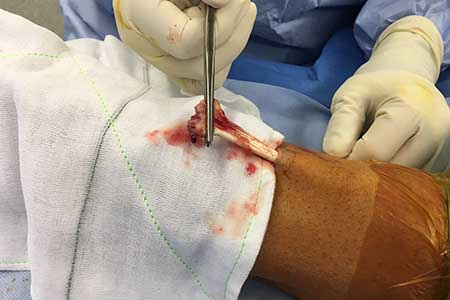What is the Bicep?
The bicep is a muscle of two parts (bi = 2) in the arm. The bicep muscle attaches to both the shoulder and the forearm. The ‘long head’ enters the shoulder and the long and ‘short heads’ combine to form ‘one’ tendon at the elbow. The long head of the biceps inserts into the supraglenoid tubercle above the glenoid in the shoulder and an injury in this area is called a SLAP lesion. The short head inserts into the Coracoid bone and is rarely injured. The tendon at the shoulder is called the proximal biceps tendon and the tendon at the elbow is called the distal biceps tendon.
Distal Biceps Tendon Rupture
Rupture of the distal biceps tendon at the elbow joint is uncommon and accounts for less than 5% of biceps tendon ruptures. There is usually some degree of degenerative change within the tendon that predisposes it to rupture and it is seen almost exclusively in males. Ruptures of the distal tendon near the elbow usually occur when an unexpected force is applied to a bent arm. This is most commonly an activity such as lifting a heavy rock or doing weights at the gym. It can also happen during sports such as a rugby tackle or a snowboarder using the arm to try to break a fall.
Without surgical repair, patients who experience complete rupture of the distal biceps tendon will notice loss of strength at the elbow. The strength will affect both the ability to bend the elbow against resistance (flexion) and the ability to turn the forearm to the palm-up position against resistance (Supination – for example, turning a doorknob). Typically patients get fatiguing and pain in the elbow with repetitive use. There may be cramping in the muscle holding a phone to the ear or holding a baby. Regardless of how much physiotherapy or gym is done the strength does not return because the muscle is no longer attached to the bone.
What are the Symptoms of Distal Biceps Tendon Rupture?
The patient usually experiences sudden pain over the front of the elbow after a forceful effort against a flexed (bent) elbow. There may be a snap and the muscle may curl up into the arm. Swelling and bruising around the elbow are common. Movement usually returns over a few days and the abnormal muscle shape becomes more obvious.
What is a Partial Tear of the Biceps?
We used to think that the two parts of the biceps muscle combined into a single tendon at the elbow but we now understand that in most people the 2 tendons travel side by side and insert into the radial tubercle. The short head is more powerful than the long head and biomechanically pulls at a slightly different angle as well. In most people a ‘partial’ tear is in fact a complete tear of the short head of the biceps, leaving the long head intact. This causes less bunching up of the muscle but tends to lead to ongoing pain and weakness because the more important part of the muscle is torn.
What is the Treatment of Distal Biceps Rupture?

Most patients who want more normal use of their arm will benefit from surgery to repair the ruptured tendon to the bone and there is no doubt that the best results are achieved with surgery (ideally within 3 weeks of the injury). After this time patients are still usually better off with surgery but may require a reconstruction procedure rather than a direct repair.
There are many ways to perform the surgery. In my opinion the safest and most reliable method of repairing the biceps tendon back to the bone is using the ‘two incision technique”. This means that small cuts are made at the front and back of the elbow to allow retrieval of the torn tendon and the reattachment of the tendon to bone.
The arm is typically protected in a splint or brace for one week and then range of motion exercises focusing on regaining supination are started. Gentle strengthening is increased gradually and somewhere between 3 and 6 months surgery full function is allowed again.
FAQs
Unfortunately in most cases when the ultrasound or MRI report says there is a partial rupture it is actually a complete rupture of one of the two tendons of the biceps. In my experience patients are not satisfied with the function of the elbow when this happens and almost everyone will eventually request surgery to have it fixed. I generally offer early surgery in these cases which gives excellent results.
The operation is performed through 2 small cuts, one on the front of the elbow and one at the back. The ‘2 incision technique’ allows more accurate reattachment of the biceps tendon to the bone in the region it was originally attached before it tore.
Most people are able to go home on the same day of the operation. If the operation is done late in the afternoon I generally keep you in hospital overnight and let you go home the next morning.
I will place a backslab (half plaster) on your arm at the end of the operation. This provides pain relief and protects the repair while the wounds are healing. This ‘splint’ is removed at one week at which time you will start your exercise programme to restore movement to your elbow. I suggest wearing a sling for about 6 weeks to remind you not to use your arm for any heavy activities while the tendon heals back to the bone.
Complete healing of the tendon to the bone takes about 6 months. At that point there are no longer any restrictions required for lifting and carrying. Most people find that the elbow functions as well as what it did prior to the surgery, although it can take up to a year for you not to notice the arm any more.